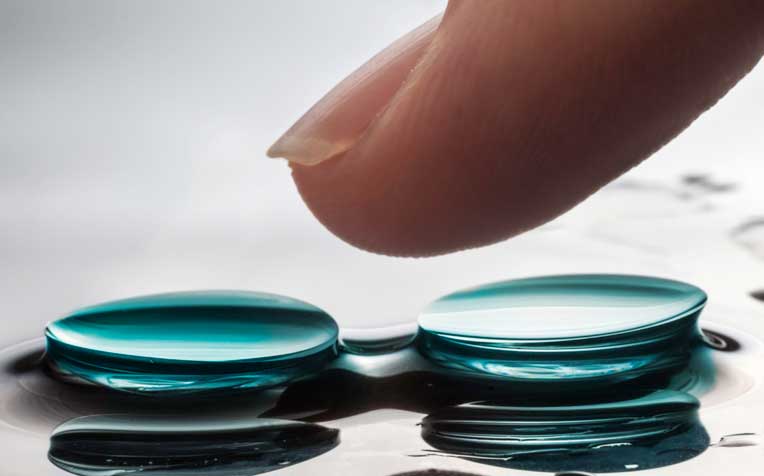
Contact lens if not cleaned properly, can cause an eye infection.
It may be convenient to wear contact lenses to sleep or swim but it can put you at risk for developing corneal ulcers, corneal abrasions and eye infections. With proper treatment, most people will recover. But for serious corneal damage and infection, you may need a corneal transplant to restore vision.
The cornea is the clear, protective layer covering the front of the eye. Wearing dirty contact lenses can cause the cornea to be infected and inflamed with corneal ulcers. Poorly-fitted contact lenses can also scratch the cornea. These corneal ulcers often result in severe eye pain and blurred vision.
"Many young working adults prefer the convenience of wearing contact lenses to glasses. To maintain healthy eyes, practise good contact lens hygiene and keep wear time down to less than eight hours a day," says Clinical Associate Professor Lim Li, Senior Consultant, Corneal and External Eye Disease Department, Singapore National Eye Centre (SNEC), a member of the SingHealth group.
When a corneal ulcer results in thinning, clouding or perforation of the cornea, a corneal transplant is required to restore vision – and save the eye, adds Clin Assoc Prof Lim Li.
Causes of corneal damage
There are several causes of corneal disease. A progressively thin cornea can lead to a disorder called keratoconus, where vision becomes distorted when the normally round-shaped cornea changes into a cone shape. Infections and injuries can cause the cornea to become increasingly cloudy and opaque, so light rays cannot reach the retina, resulting in poor vision or corneal blindness.
Besides contact lens misuse, corneal damage can result from:
- Trauma caused by external eye injuries
- Degeneration of the innermost layer of the cornea called endothelium, due to ageing
- Eye diseases such as keratoconus and herpes simplex virus
What is a corneal transplant?
A corneal transplant is a procedure in which the damaged or diseased cornea is removed and replaced with a new donor cornea.
In traditional corneal transplant (penetrating keratoplasty), the surgeon cuts through the entire thickness of the damaged or diseased cornea and removes a recipient button of approximately 8mm in size. The round donor cornea is then placed on the recipient and secured with fine sutures.
Types of corneal trasplant include:
1. Lamellar keratoplasty
In corneal transplant techniques such as anterior lamellar keratoplasty (ALK), only the superficial, damaged or diseased front layers of the cornea are removed, thus preserving the corneal endothelium, the deep, innermost layer of the cornea.
Deep anterior lamellar keratoplasty (DALK) is similar to ALK except that it removes nearly all of the front layers of the cornea down to almost the deepest layer - Descemet’s membrane.
Surgeons usually perform these corneal transplant procedures for misshapen corneas (keratoconus) and corneal scars. About 30 per cent of SNEC’s corneal transplants are ALK and DALK procedures. SNEC is one of few transplant centres in the world that perform this many advanced lamellar keratoplasties.
2. Endothelial keratoplasty: a form of sutureless corneal transplant
In advanced corneal transplant procedures such as DMEK (Descemet’s membrane endothelial keratoplasty) and DSAEK (Descemet's stripping automated endothelial keratoplasty), only the diseased innermost endothelial layer is replaced, leaving most of the original cornea intact.
"Endothelial keratoplasty is probably the most significant advance in corneal transplantation, because it is essentially a form of sutureless, keyhole corneal transplantation", says Clin Assoc Prof Lim Li.
As it requires only a small incision at the side of the cornea and no sutures on the surface of the cornea, the eye is much stronger, visual recovery is faster and there is less refractive unpredictability. More than 40 per cent of corneal transplants at SNEC are endothelial keratoplasty.
"Although complications can happen as with any surgical procedure, advanced surgical techniques e.g. with our Endoglide (developed at SNEC) have reduced these and made corneal transplantation a relatively safe surgery with shorter recovery time and lower risk of rejection," says Clin Assoc Prof Lim Li.
SNEC’s corneal transplant program was initiated in 1991. SNEC performs 250-300 corneal transplants a year with an overall graft survival rate exceeding 90 per cent, and which is close to 100 per cent with new procedures like endothelial keratoplasty. SNEC is one of the leading centers in the world in the field of endothelial keratoplasty.
Ref. L20
Contributed by
















 Get it on Google Play
Get it on Google Play